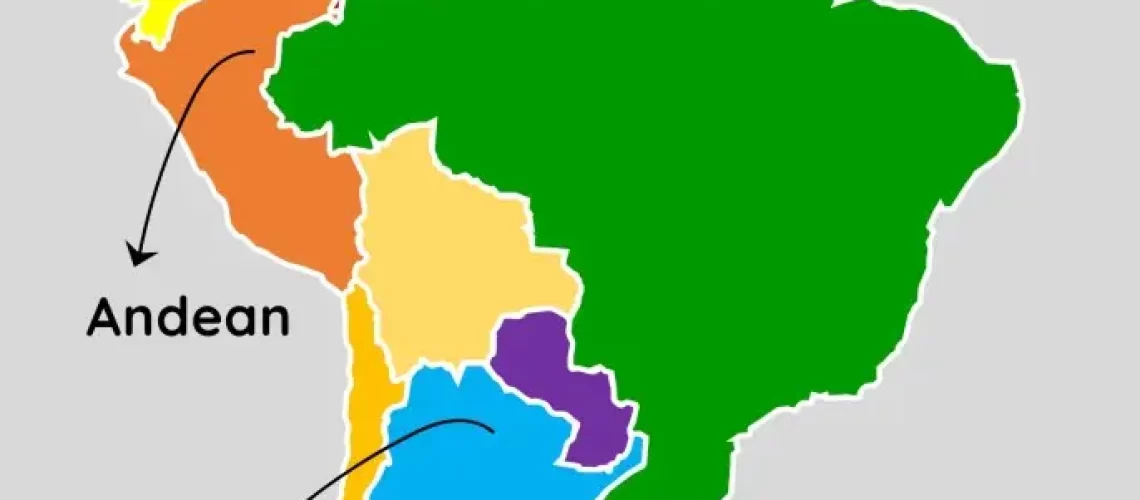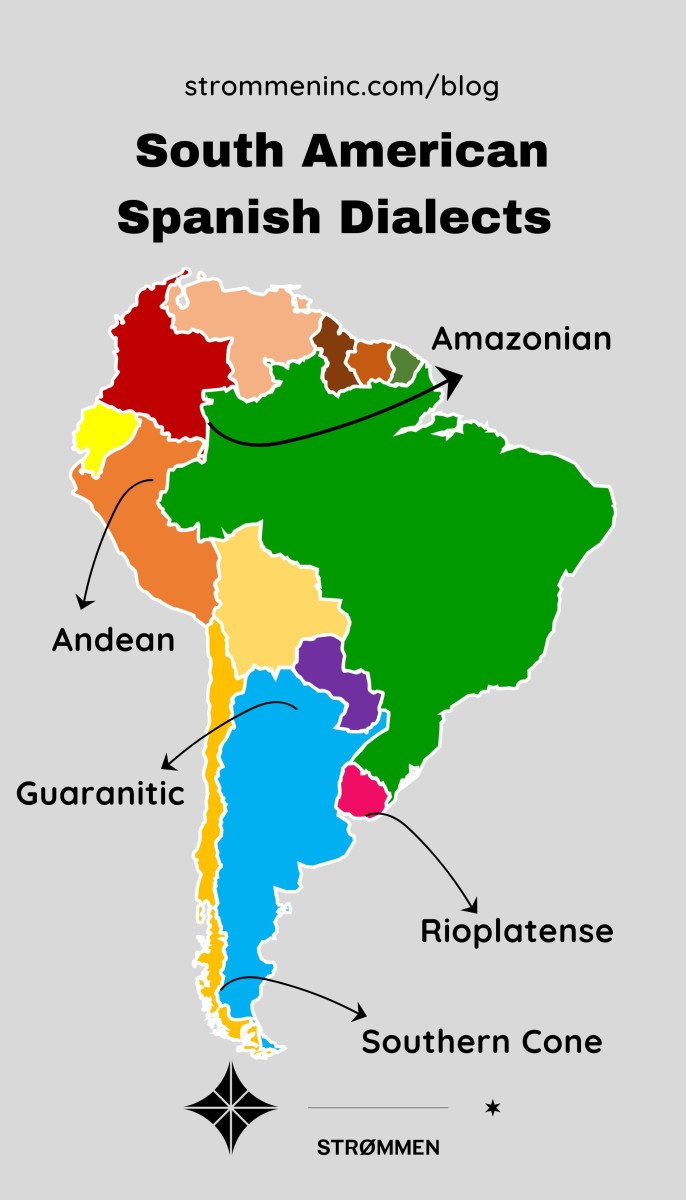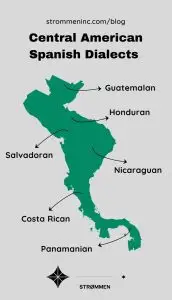Although Spanish is widely spoken throughout South America, it does not sound the same everywhere. Argentina’s rolling accents, Colombia’s crisp tones, and Chile’s fast-paced rhythm all contribute to the language’s distinct taste. These variations are referred to as South American Spanish dialects, and they represent centuries of history, geography, and cultural influences.
Understanding these dialects is more than just learning new terminology; it is also about learning how people actually communicate in their daily lives. Knowing the primary South American Spanish dialects will help you seem more natural and confident, whether you’re planning a trip, communicating with Spanish speakers online, or working with a tutor.
In this guide, we’ll explore the most widely spoken dialects across South America, highlight what makes each unique, and give you a clear picture of how Spanish changes from country to country.
What Makes South American Spanish Unique?
Spanish across South America is rooted in Castilian Spanish from Spain, but each region has shaped it in its own way. What makes it unique? A mix of indigenous influence, migration, and local culture.
Here are the main factors that set South American Spanish apart:
Indigenous languages
- Quechua and Aymara in the Andes
- Guaraní in Paraguay (often mixed directly into speech)
- Amazonian languages and Portuguese influences near Brazil
Migration and cultural exchange
- Italian immigration in Argentina/Uruguay → melodic Rioplatense Spanish
- Caribbean and African influences in coastal Venezuela and Colombia → faster, more rhythmic Spanish
Grammar differences
- Use of voseo (vos instead of tú) in Argentina, Uruguay, and parts of Central/Andean regions
- Some countries stick to traditional tú
Pronunciation
- Some dialects are clear and careful (Bogotá, Quito)
- Others drop consonants or shorten words (Chile, Caribbean coast)
| Feature | Where It’s Common | Example for Learners |
| Voseo (vos) | Argentina, Uruguay, Paraguay, parts of Bolivia | Vos tenés (you have) instead of tú tienes |
| Dropped consonants | Chile, Caribbean Colombia/Venezuela | está bien → ’ta bien (it’s okay/it’s fine) |
| Indigenous words | Andes, Paraguay, Amazon | guagua (child, bus), choclo (corn) |
| Italian-like intonation | Argentina, Uruguay | Rising, musical rhythm of speech |
Andean Spanish: Dialects of the South American Highlands
Andean Spanish is spoken across the highland regions of Colombia, Ecuador, Peru, Bolivia, northern Chile, and northwestern Argentina. It’s known for its clear pronunciation, slower rhythm, and strong influence from indigenous languages such as Quechua and Aymara. Because of its clarity and careful enunciation, many learners find Andean Spanish easier to understand compared to faster coastal varieties.
Andean Spanish shows the cultural diversity of the Andes, combining Spanish roots with indigenous language and idioms that have endured for centuries.
Colombian Andean Spanish
Colombian Spanish, especially in Bogotá, is often praised as one of the clearest and most “neutral” varieties of Spanish in Latin America. It features careful pronunciation, slower pacing, and relatively little slang compared to coastal Colombian dialects. This makes it particularly attractive to language learners and is often the variety chosen for international media.
- Region: Bogotá and the central Andean highlands of Colombia
- Influences: Castilian Spanish, local indigenous languages
- Interesting Fact: Bogotá Spanish is frequently used in educational materials and dubbed films because it’s considered easy to understand.
Ecuadorian Andean Spanish
In Ecuador, the highland variety of Ecuadorian Spanish spoken in Quito and surrounding areas is marked by a polite, formal tone. Ecuadorians often use usted even among friends and family, reflecting cultural values of respect. Pronunciation tends to be crisp and deliberate, though strongly influenced by Quechua in rural areas.
- Region: Quito and the central Andean highlands
- Influences: Quechua, indigenous vocabulary
- Interesting Fact: Despite being a small country, Ecuador shows dramatic contrasts: coastal Spanish is fast and informal, while Andean Spanish remains formal and precise.
Peruvian Andean Spanish
Peruvian Spanish has one of the strongest indigenous influences on the continent, especially in regions like Cusco and Ayacucho. Quechua grammar and rhythm seep into the Spanish, giving it a distinctive cadence. It is slower and more melodic than coastal Peruvian Spanish, and it preserves many indigenous loanwords.
- Region: Highlands of Peru, especially Cusco and Ayacucho
- Influences: Heavy Quechua influence in pronunciation and vocabulary
- Interesting Fact: Cusco Spanish often mirrors Quechua’s rhythm, making it sound musical compared to other varieties.
Bolivian Andean Spanish
Bolivian Spanish, particularly in La Paz and the Altiplano, is perhaps the most “Andean” of all. It carries strong Aymara and Quechua influences, not only in vocabulary but also in syntax and pronunciation. Speech tends to be formal and deliberate, with clear enunciation and respect markers common in daily interaction.
- Region: Western Bolivia, particularly La Paz and the Altiplano
- Influences: Aymara and Quechua
- Interesting Fact: Bolivian highland Spanish often incorporates direct translations of indigenous expressions, creating unique turns of phrase not found elsewhere.
Amazonian Spanish: Dialects of the South American Rainforest
Amazonian Spanish is spoken in the lowland rainforest areas of Peru, Ecuador, Colombia, and near the Brazilian border. Unlike the crisper, slower Andean variety, Amazonian Spanish has a softer, more fluid tone and frequently combines with rainforest indigenous languages. In border regions, Portuguese influence is also obvious, particularly in vocabulary and pronunciation.
Because of its location, Amazonian Spanish carries unique expressions that reflect the biodiversity and culture of the Amazon. Many of these words describe local plants, animals, and traditions that don’t exist elsewhere, making this variety especially rich in vocabulary.
Peruvian Amazonian Spanish
Peruvian Spanish of the Amazons is widely spoken in cities like Iquitos and Pucallpa. It is known for its melodic intonation and frequent borrowing from indigenous Amazonian languages. Compared to coastal and Andean Peruvian Spanish, it has a lighter, more relaxed rhythm.
- Region: Peruvian Amazon, especially Loreto and Ucayali (Iquitos, Pucallpa)
- Influences: Indigenous Amazonian languages (Shipibo, Asháninka, and others)
- Interesting Fact: Iquitos, the largest city in the Peruvian Amazon, is only accessible by river or air; its Spanish reflects centuries of cultural isolation and blending.
Ecuadorian Amazonian Spanish
Ecuadorian Spanish of the Amazons is spoken across the Oriente region. It retains many features of highland Spanish but mixes in indigenous vocabulary from languages like Kichwa and Shuar. The rhythm is slower than coastal Ecuadorian Spanish, with a softer tone overall.
- Region: Eastern Ecuador, particularly the Amazonian provinces (Napo, Pastaza, Orellana)
- Influences: Kichwa, Shuar, and other indigenous languages
- Interesting Fact: Many communities in the Ecuadorian Amazon are bilingual, switching fluidly between Spanish and Kichwa in daily conversation.
Colombian Amazonian Spanish
Colombian Amazonian Spanish is spoken in Leticia and the surrounding border regions with Peru and Brazil. It has a distinctive mix of Colombian clarity, indigenous vocabulary, and some Portuguese borrowings. Its speakers are often multilingual, navigating between Spanish, Portuguese, and indigenous tongues.
- Region: Colombian Amazon, especially Leticia and border towns
- Influences: Portuguese (due to Brazil), indigenous Amazonian languages
- Interesting Fact: In Leticia, it’s common to hear Spanish, Portuguese, and Tikuna (an indigenous language) spoken in the same marketplace.
Caribbean Spanish: Dialects of Northern South America
Caribbean Spanish is spoken along the northern coast of South America, including Venezuela and coastal Colombia. This variety is characterized by fast, melodic speech, dropped consonants, and a rich use of local slang. The rhythm and intonation are heavily influenced by Caribbean Spanish spoken in the islands, such as Cuba and the Dominican Republic, making it distinct from inland dialects like Andean or Guaranitic Spanish.
For learners, Caribbean Spanish can be challenging at first due to its rapid pace and informal contractions, but it offers a lively and authentic glimpse into the culture and everyday communication of coastal communities.
Venezuelan Spanish
Venezuelan Spanish is spoken throughout most of Venezuela, particularly in Caracas, Maracaibo, and coastal cities. It features a melodic intonation, dropped final consonants, and abundant local slang, giving it a unique sound compared to inland Spanish varieties.
- Region: Northern Venezuela, including Caracas and coastal cities
- Influences: Caribbean Spanish, Indigenous languages, African languages
- Interesting Fact: Coastal Venezuelans often drop the “s” at the ends of syllables (los amigos → lo’ amigo’), giving the speech a distinctive, fluid rhythm.
Coastal Colombian Spanish
Coastal Colombian Spanish is spoken along the Caribbean coast, in cities like Barranquilla, Cartagena, and Santa Marta. It shares many traits with Venezuelan Spanish, including fast speech, dropped consonants, and a heavy use of colloquial expressions. This variety also has some African linguistic influences due to the history of coastal communities.
- Region: Northern Colombia, Caribbean coast (Barranquilla, Cartagena, Santa Marta)
- Influences: Caribbean Spanish, African languages, Indigenous languages
- Interesting Fact: Many coastal Colombians mix Spanish with English words, especially in port cities, reflecting the historical influence of trade and tourism.
Guaranitic Spanish: Dialects of the Paraguay Region
Guaranitic Spanish refers to the varieties of Spanish spoken in Paraguay and parts of northeastern Argentina, southern Brazil, and eastern Bolivia. This region is unique because Spanish coexists with Guaraní, one of the few indigenous languages in the Americas with nationwide official status. The result is a bilingual environment where most people comfortably switch between Spanish and Guaraní, or even mix the two in daily conversation.
Guaranitic Spanish stands out for its heavy indigenous influence, frequent use of Guaraní loanwords, and distinctive intonation. It is less influenced by European migration than Rioplatense Spanish, making it sound different from neighboring Argentina and Uruguay.
Paraguayan Spanish
Paraguayan Spanish is perhaps the most bilingual variety in South America. Everyday speech includes many Guaraní words, expressions, and even grammatical structures. Speakers often alternate between Spanish and Guaraní depending on the setting, and sometimes blend the two languages into what locals call Jopará.
- Region: Paraguay (nationwide)
- Influences: Guaraní (vocabulary, syntax, intonation)
- Interesting Fact: About 90% of Paraguayans speak both Spanish and Guaraní, making Paraguay one of the most bilingual countries in the world.
Northeastern Argentine Spanish (Corrientes Province)
In Argentina’s Corrientes Province, Spanish also shows strong Guaraní influence. Although officially part of Argentina, Corrientes has deep cultural ties to Paraguay, and the local dialect reflects this heritage.
- Region: Northeastern Argentina, especially Corrientes
- Influences: Guaraní, Rioplatense Spanish
- Interesting Fact: Corrientes is the only Argentine province where Guaraní has official co-language status alongside Spanish.
Bolivian Lowland Spanish (Santa Cruz, Tarija)
In eastern Bolivia, Spanish spoken in Santa Cruz and Tarija also belongs to the Guaranitic sphere. It combines influences from Guaraní with features of neighboring Rioplatense and Amazonian Spanish varieties.
- Region: Eastern Bolivia, particularly Santa Cruz and Tarija
- Influences: Guaraní, Andean Spanish, Amazonian Spanish
- Interesting Fact: Many rural communities in this region still use Guaraní as their first language, with Spanish often learned second.
Rioplatense Spanish: Dialects of the Río de la Plata Region
Rioplatense Spanish is spoken in the Río de la Plata basin, covering Argentina and Uruguay. It’s one of the most distinctive South American Spanish dialects, instantly recognizable for its Italian-like intonation and widespread use of voseo (vos instead of tú). Learners often describe it as melodic, almost musical, thanks to the influence of Italian immigration in the 19th and 20th centuries.
This variety is also deeply tied to cultural identity. Tango lyrics, Buenos Aires slang (lunfardo), and even everyday conversations all showcase the unique rhythm and vocabulary of Rioplatense Spanish.
Argentinian Spanish
Argentinian Spanish, especially in Buenos Aires, is the most famous example of Rioplatense. It features a rising intonation that sounds similar to Italian, reflecting the country’s immigrant history. In addition to voseo, it’s full of slang words, many of them borrowed from Italian, French, and indigenous languages.
- Region: Argentina, especially Buenos Aires and surrounding provinces
- Influences: Italian (intonation, loanwords), Lunfardo slang, indigenous languages (Quechua, Mapuche)
- Interesting Fact: Buenos Aires Spanish often uses the “sh” or “zh” sound for the letters “ll” and “y,” so yo (I) sounds like “sho” or “zho.”
Uruguayan Spanish
Uruguayan Spanish shares most traits with Argentinian Rioplatense but has subtle differences in vocabulary and intonation. Montevideo speech is especially close to Buenos Aires, while interior regions sound slightly softer and more rural. Like Argentina, Uruguay uses vos instead of tú in daily life.
- Region: Uruguay, especially Montevideo and the Río de la Plata coast
- Influences: Italian (intonation), Portuguese (from Brazil), Lunfardo slang
- Interesting Fact: In border areas with Brazil, speakers often code-switch between Spanish and Portuguese, creating a hybrid speech known as Portuñol.
Southern Cone Spanish: Dialects of Southern South America
Southern Cone Spanish refers to the Spanish variants spoken in South America’s southernmost regions, namely Chile, southern Argentina, and parts of Bolivia. These dialects share some characteristics, such as distinct intonation patterns, melodic speech, and region-specific vocabulary, but they also differ in ways that reflect local history, culture, and indigenous influences.
Southern Cone Spanish is particularly interesting for learners because it contrasts sharply with the more neutral or coastal varieties of Spanish, offering a rich mix of pronunciation, grammar, and slang.
Chilean Spanish
Chilean Spanish is spoken throughout central and coastal Chile. It is known for its rapid pace, dropped consonants, and creative slang, often called chilenismos. Learners may find it challenging at first, but it provides a fascinating glimpse into Chilean identity and culture.
- Region: Central and coastal Chile, especially Santiago
- Influences: Castilian Spanish, Mapudungun (indigenous), European immigration
- Interesting Fact: Many Chilean words are contractions or borrowings from Mapudungun, giving the dialect a colorful and unique vocabulary.
Patagonian Spanish
Patagonian Spanish is spoken in southern Argentina and southern Chile, including Tierra del Fuego. It features a slower rhythm and clearer pronunciation than northern Rioplatense varieties, and includes vocabulary influenced by indigenous peoples and rural communities.
- Region: Southern Argentina and Chile (Patagonia region)
- Influences: Rioplatense Spanish, indigenous languages
- Interesting Fact: Patagonian Spanish is often easier for learners to understand than Buenos Aires Spanish due to its slower, more deliberate speech.
Cuyo Spanish
Cuyo Spanish is found in the western provinces of Argentina, such as Mendoza, San Juan, and San Luis. This variety blends Rioplatense and Chilean influences, reflecting historical migration and trade patterns across the Andes.
- Region: Western Argentina (Mendoza, San Juan, San Luis)
- Influences: Rioplatense Spanish, Chilean Spanish, Andean Spanish
- Interesting Fact: Cuyo Spanish has subtle pronunciation shifts that reflect its location near the Andes, creating a mix of coastal and highland sounds.
How Strommen Teaches South American Spanish Dialects
Strommen recognizes that South American Spanish is extremely diverse, with each region having its own pronunciation, lexicon, and rhythm. That’s why our courses are designed to help students master both the language and its regional variations.
Students study with native-speaking tutors from specific nations or areas to practice realistic pronunciation, local slang, and conversational styles. Lessons include audio, video, and interactive tasks, allowing students to internalize terminology and cultural context naturally. Strommen, whether online or in person, lets students specialize in a certain dialect, such as Rioplatense, Andean, or Amazonian Spanish, or experiment with numerous kinds, developing the confidence to interact naturally with locals throughout South America.
Bringing South American Spanish to Life
South American Spanish is a diverse set of dialects, each influenced by history, geography, and culture. From the melodic tones of Rioplatense Spanish in Argentina and Uruguay to the clear, slow rhythm of Andean Spanish, the bilingual flavor of Guaranitic Spanish, and the lively pace of Caribbean coastal varieties. Each dialect provides a unique perspective on the language and its speakers. Understanding these differences not only enhances comprehension but also allows you to connect more authentically with natives wherever you go.
Are you ready to start speaking like a local?
Strommen allows you to choose your own dialect, learn directly from native teachers, and practice in real-life conversations, all at your own pace and goals. Explore South American Spanish as it is spoken, and take your language skills to the next level now.
Contact us for a consultation with our learning experts, or find a tutor near you!





